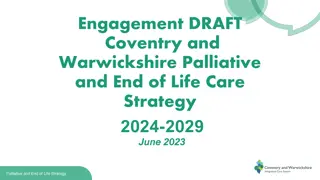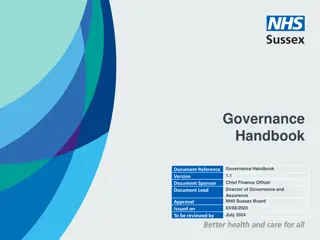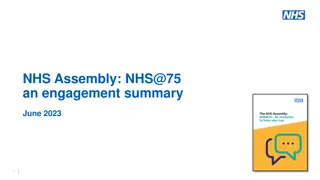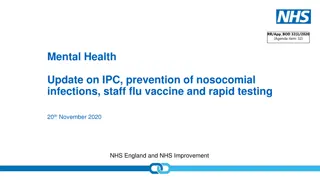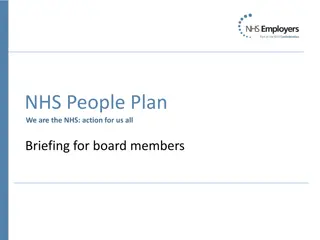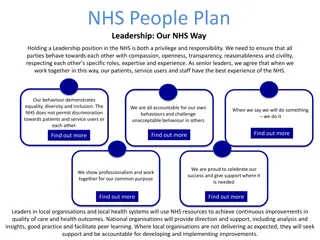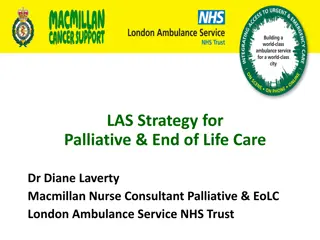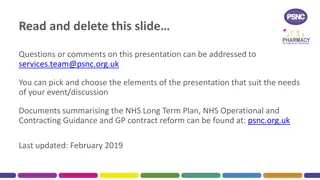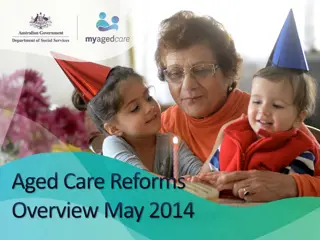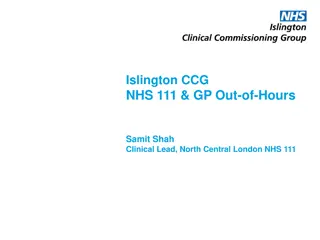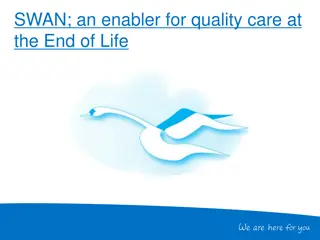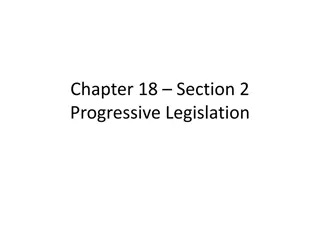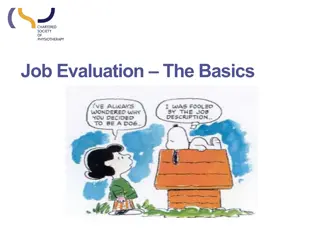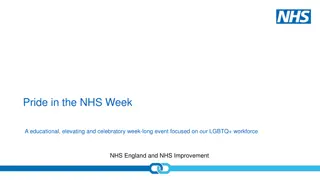Improving End-of-Life Care in NHS: Updates and Reforms
National Clinical Director Prof. Bee Wee highlights NHS efforts to enhance end-of-life care through personalized approaches, new service models, and GP quality frameworks. The NHS Long-Term Plan emphasizes proactive care planning for patients in their last year of life, while additional focus is placed on children's palliative care. Investment and Reform initiatives intend to reform the GP contract through quality improvement activities and engagement to ensure better care coordination and support for patients and families.
Download Presentation

Please find below an Image/Link to download the presentation.
The content on the website is provided AS IS for your information and personal use only. It may not be sold, licensed, or shared on other websites without obtaining consent from the author.If you encounter any issues during the download, it is possible that the publisher has removed the file from their server.
You are allowed to download the files provided on this website for personal or commercial use, subject to the condition that they are used lawfully. All files are the property of their respective owners.
The content on the website is provided AS IS for your information and personal use only. It may not be sold, licensed, or shared on other websites without obtaining consent from the author.
E N D
Presentation Transcript
National End of Life Care Update Prof Bee Wee National Clinical Director for End of Life Care, NHS England 2ndMay 2019 NHS England and NHS Improvement
National update NHS Long Term Plan Personalised approach New service models older people, children and young people GP Quality and Outcomes Framework Priorities and approach for 2019/20 Responding to challenges 2 | 2 | Presentation title
NHS Long Term Plan: Para 1.42 Para 1.42. With patients, families, local authorities and our voluntary sector partners at both national and local level, including specialist hospices, the NHS will personalised care, to improve end of life care. By rolling out training to help staff identify and support relevant patients, we will introduce proactive and personalised care planning for everyone identified as being in their last year of life .. 3 |
NHS Long Term Plan: Para 3.41 Children s palliative and end of life care increase contribution by match-funding CCGs who commit to increase their Investment in local children s palliative and end of life care services including children s hospices up to a combined total of 25 million/year by 2023/24. 4 |
Investment and Reform: 5 year framework for GP Contract Reform: QOF reforms Aims - improvement in: 1. Early identification and support for people with advanced progressive illness who might die within the next 12 months 2. Well-planned and coordinated care that is responsive to the person s changing needs with the aim of improving the experience of care 3. Identification and support for family/informal caregivers, both as part of the core care team around the patient and as individuals facing impending bereavement 5 |
Investment and Reform: 5 year framework for GP Contract Reform: QOF reforms Practices need to: Evaluate current quality of their end of life care and identify areas for quality improvement e.g. retrospective death audit Identify quality improvement activities and set improvement goals Implement the improvement plan Participate in a minimum of 2 GP network peer review meetings Complete QI monitoring template in relation to this module 6 |
Investment and Reform: 5 year framework for GP Contract Reform: Focus on: contractor engagement, participation in quality improvement activity in own practice and shared learning across network 7 |
Comprehensive Model for Personalised Care All age, whole population approach to Personalised Care TARGET POPULATIONS INTERVENTIONS OUTCOMES Specialist Empowering people, integrating care and reducing unplanned service use. Integrated Personal Commissioning, including proactive case finding, and personalised care and support planning through multidisciplinary teams, personal health budgets and integrated personal budgets. People with complex needs 5% Plus Universal and Targeted interventions Targeted Supporting people to build knowledge, skills and confidence and to live well with their health conditions. Proactive case finding and personalised care and support planning through General Practice. Support to self manage by increasing patient activation through access to health coaching, peer support and self management education. People with long term physical and mental health conditions 30% Plus Universal interventions Universal Shared Decision Making. Enabling choice (e.g. in maternity, elective and end of life care). Social prescribing and link worker roles. Community-based support. Supporting people to stay well and building community resilience, enabling people to make informed decisions and choices when their health changes. Whole population 100% 8 | 8 |
Significant delivery of Personalised Care Personalised care and support planning Enabling choice Shared decision making 142,904 people had a personalised care and support plan between April 2017 and September 2018 Over 204,000 people supported by integrated, personalised approaches 97% of CCGs have now completed Choice Planning and Improvement self-assessment Of these, 85% report compliance with at least 5 (of 9) choice standards In 2017/18 SDM was embedded into: Musculoskeletal elective care pathways across 13 CCGs Respiratory elective care pathways in 8 CCGs Personal health budgets & integrated personal budgets Social prescribing & community-based support Supported self management 32,341 PHBs by September 2018 Up 110% year-on -year in 2018 (to end Q2) 23% jointly funded with social care 55,511 Personal Maternity Care Budgets delivered by September 2018 across 36 CCGs 101,637 patient activation assessments by September 2018 Over 44,093 people referred to community-based support Over 59,545 people referred to self- management education or health coaching 68,977 referrals in 2017/18 331 link workers employed in local areas 10 | 10 |
Other high level commitments from 2019/20 Maternity 52% of women will receive a personalised care plan by March 2020 (32% by March 2019) End of Life Care Increase the percentage of people who have died who had been offered the opportunity for personalised care and support planning, from 39.6% to 75% in 10 years 11 | 11 |
Core Objectives DH Mandate Increase the percentage of people identified as likely to be in their last year of life, so that their End of Life Care can be improved by personalising it according to their needs and preferences. UPC Target Increase the percentage of people who have died who had been offered the opportunity for personalised care and support planning, from 39.6% to 75% in 10 years. Long Term Plan (1.42) Roll out training to help staff identify and support relevant patients, we will introduce proactive and personalised care planning for everyone identified as being in their last year of life. 12 |
Deliverables Implementation of QOF QI The Quality and Outcomes Framework - Quality Improvement (QOF QI) aims to improve; early identification and support for people, well-planned and coordinated care and identification and support for family/informal caregivers. Survey of Bereaved People (VOICES-SF). Collaboratively working with the Insight and Feedback team to focus on local options to gain feedback on the Quality of care delivered in the last 3 months of life for adults who died. As part of an ICS or place based project this aims to reduce the number of trusts rated as inadequate or requires improvement by the CQC. Improved outcomes and experience in EoLC NHSI Getting to Good Programme Early identification tools within electronic systems using read codes The project will look to commence a wider testing of the screening tools (test sites) as well as translating the toolkit from EMIS to SystmOne. CHC SIP Using a place-based approach properly test the hypothesis that improved identification, and personalised EoLC will reduce the use of CHC Fast track. Build and continue to develop a joint narrative with CHC SIP/ADASS/EoL
Wider Community Workforce Patients and Carers Demonstrator Champion and Mentor Programme Professional Programme Evidence Policy and Infrastructure Enablers (LE, FCC etc) Delivery Innovation (formerly Testing) Programme National Support offer Regional offer for NHSE/I teams System offer for ICS/STPs Place offer for CCGs Neighbourhood offer for Primary Care Networks 14 |
National Support offer- available to all Sharing good practice, signposting, peer support NHS England has commissioned Hospice UK to work with a limited number of hospices to explore mechanisms for raising awareness and expectations about the governments 6-point commitment amongst patients, their families and the wider community case studies will be available in 19/20 Q2. NHS England has sponsored a Moving Pictures Brief to raise awareness about the importance of talking about death and dying, planning for the future, and thinking and talking about a time when you are going to be less well, including when you are dying. The winning animation will be announced in 19/20 Q1. NHS England has commissioned Hospice UK to identify the critical components of hospice-led interventions and service models that are effective in preventing avoidable admission to hospital, or supporting early discharge and transfer from hospital for people approaching the end of life. The report is due 19/20 Q1 and will provide an evidence-base for end of life care service re-design. Hospice UK Awareness Raising (Commitments) RSA Student Design Awards Hospice UK - Holistic
National Support offer- contd A group of stakeholders have developed a service specification & commissioning model which is to be tested in 2 regions over the next 12 months. This draft model will be published in 19/20 to share best practice commissioning for C&YP. The EoLC mailbox is single point of access, the team will respond or signpost as appropriate. ENGLAND.endoflifecare@nhs.net Commissioning Models for PEoLC for CYP Generic Mailbox The Personalised Care Group NHSFuture Collaboration platform will signpost to the knowledge hub on the Ambitions website and our resources page. Collaboration Platform Webinars provide support to professionals by raising awareness of subjects, they also share good practice. Webinar recordings are available on the NHS England website, slides are available upon request. Webinar Series
National Support offer- contd The Ambitions website contains published best practice, case studies, implementation guidance and lessons learnt, the National EoL Programme Board papers are also available. Ambitions Partnership To share good practice, develop best practice, peer support, collaborative working, getting to outstanding in EoLC, sharing the national agenda and the LTP, support the CNO and NCD in ensuring EoLC continues to improve, share the outputs and support service improvement requirements of the NACEL To provide a focus for strategic clinical leadership for palliative and end of life care reaching across every STP/ICS and maximising potential for effective communication and shared learning National EoLC Practitioners network Palliative and End of Life Care Clinical Leaders Support/Ment oring (PCG demonstrator site leads) End of Life Care Team can provide support and signposting for site leads.
Place offer Supports delivery of the core objectives and one or more of the proposed deliverables for 19/20 Place based project in each of 7 regions Project assurance provided by the National EoL Team
Neighbourhood offer - available to Primary Care Networks Work with our partners to develop and deliver a support offer for GP practices and Primary Care Networks to demonstrate continuous quality improvement focused on end of life care Support for QOF Quality Improvement
EoL Programme: how it all fits together 6 point commitment Honest conversations Informed decisions Developing personalized care plan Sharing plan with professionals Involving family to the extent wishes Know who to contact 20 |
National update NHS Long Term Plan Personalised approach New service models older people, children and young people GP Quality and Outcomes Framework Priorities and approach for 2019/20 Responding to challenges 21 | 21 | Presentation title
Complex challenging world More demand Less workforce More expectations Know more about less Struggle with acknowledging limits Diminished respect for authority, expertise Speed of communication https://www.bluehomepm.com/common-myths- investing-in-florida-real-estate-from-canada/complex/ 22 | 22 | Presentation title
Palliative care: specific features Crosses biomedical, social and societal boundaries Approach that integrates art and science Attracts public, media and political interest Dying and death happens to everybody Hugely emotive personal stories Managing boundaries Palliative care leaders: driving forward the specialty supporting colleagues at generalist level managing expectations seeing wood for trees 23 | 23 | Presentation title
Burning platform.. Of 1.4 million people who work in the NHS in England: > 50% unable to meet all the conflicting demands at work Nearly 40% - unwell as a result of stress in the past year Around 50% more debilitating levels of work stress compared with general working population 44% only - able to make improvements in their area of work 24 | 24 | Source: West M, King s Fund 2017 Presentation title
Staff wellbeing Link between quality of patient care and staff wellbeing Low staff engagement leads to: Lower patient experience Lower productivity Increased risk of workplace accidents Higher levels of staff turnover Higher rates of burnout 25 | 25 | Presentation title
How leaders think: shift in mental model Volume Value Patient satisfaction Patient as partner Decrease per unit cost and waste Increase revenue Organised through large hospitals Redesign delivery of care Quality departments and experts QI in daily work for all Swensen S, Pugh M, McMullan C, Kabcenell A. High-Impact Leadership: Improve Care, Improve the Health of Populations, and Reduce Costs. Cambridge, MA: Institute for Healthcare Improvement; 2013. Available on www.ihi.org. 26 | 26 |
How leaders behave 1. Person-centredness 2. Front line engagement 3. Relentless focus on vision and strategy 4. Transparency results, progress, aims, defects 5. Across boundaries Swensen S, Pugh M, McMullan C, Kabcenell A. High-Impact Leadership: Improve Care, Improve the Health of Populations, and Reduce Costs. Cambridge, MA: Institute for Healthcare Improvement; 2013. Available on www.ihi.or 27 | 27 |
IHI high impact leadership framework: where leaders focus effort Swensen S, Pugh M, McMullan C, Kabcenell A. High-Impact Leadership: Improve Care, Improve the Health of Populations, and Reduce 28 | 28 | Presentation title Costs. Cambridge, MA: Institute for Healthcare Improvement; 2013. Available on www.ihi.org.

 undefined
undefined



